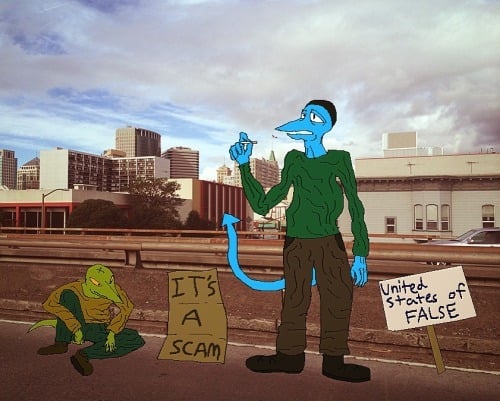Is there a better source for this than a graph on Facebook that adds up to 100.02%?
"Please note that the percentages in these pie graphs do not add up to 100% because the math was done by a woman.
For those of you hissing at that joke, it should be uh noted that that joke was written by a woman.
So, now you don’t know what the hell to think, huh?
Nah, I’m just kidding. We don’t hire women."
-Norm MacDonald, Weekend Update
I, too would like a source with a better breakdown.
But it’s not surprising that a computer would round up when dealing with under 0.01% on a graph.
I’m guessing it’s a rounding error with some of the entries being less than 0.01. Also it’s twitter.
Poll 7 people on their favorite color. 2 people pick red (29%), 2 people pick green (29%), 3 people pick blue (43%). 29+29+43=101%.
I would assume that all, or most of the 0.01% are actually less than that, but no one wanted to read a bunch of 0.007% on a pie chart.
In this thread: people who don’t know the difference between revenue and profit.
I’m not trying to discredit the protests, they are completely valid, but this chart is meaningless for comparisons. The profits can be calculated and would be much more meaningful even if the numbers aren’t perfect.
Hollywood accounting is notoriously untrustworthy, so any calculation of profit/loss is pretty suspect to me.
It’s a pretty common tactic that they end up making “no money” on even huge films because of how they fudge the numbers.
That’s why they are talking revenue here because it gets around the sketch accounting.
It may be true that it is difficult to accurately calculate the studio’s profits however that does not change the fact that comparing worldwide revenue to individual costs provides no meaningful conclusions without knowing the rest of the costs. I agree that the writers and actors are being treated unfairly but the pie chart is obviously flawed.
Properly paying writers and actors are some of their expenses though, not random unrelated people that want money. Using revenue here makes sense to me.
Imagine that the studio makes a movie that uses a famous song, actor, or other piece of intellectual property that is very expensive but they know it will boost box office sales. They might spend $5 million on this IP and it might generate $6 million in additional revenue.
Now, some people look at the $6 million in revenue and ask where their cut is. Of course the studio doesn’t actually have the $6m, they only have $1m after paying for the IP. Extrapolate this out for a whole movie.
This is why it doesn’t make mathematical sense to compare your wage to revenue - it is ignoring business fundamentals. Instead we need to look at profit which already has all expenses subtracted out. Profit is where any additional compensation must come from, or the studio needs to cut expenses elsewhere.
Sure, so long as you’re cutting all the expenses out of the revenue too, and not just union dues. The whole trick of this chart is to make pretend like writers, actors, etc are only getting 0.01% slices of the pie and the studio keeps the rest. When the actual actors (as opposed to the union itself) are going to be a big chunk of that revenue, as are the actual writers, editors, special effects, sets, costumes, etc, etc.
The point the chart is trying to make (I assume) is that if you’re dealing with such a small part of the pie, it’s not actually worth arguing over unless you’re just being greedy.
If you gave all of those unions 100% compensation increases it would now be 0.06% of studio revenue. Tell me with a straight face you think that their margins are so tight that sharing up that percentage of revenue would suddenly make movies an unprofitable venture.
That black pie chart is really confusing. The main part of the chart is labelled “Studio Revenues”, but the small slice is various costs? Why would you have revenues and costs in the same pie chart? I understand comparing revenues vs. costs, but that’s not how you use pie charts. Pie charts ad up to 100% and describe how each section contributes to the total. So, what’s the overall thing being measured here, “money that exists in Hollywood?” Because, if it’s revenues, of course SAG-AFTRA contracts aren’t revenues for the studios. If it’s costs, then why is the big section labelled “Studio Revenues”?
Also, what are the “estimated totals of each major union and guild contract”? SAG-AFTRA is listed there, but surely that can’t include all the amount they pay actors. Is that just the contractual minimums? Is it money that SAG-AFTRA and the other unions receive, but not the money that the members of those unions receive?
I get the concept they’re trying to convey. Compared to the money the studios rake in, the amount that the unions are asking for is minimal. But, this is not how you use a pie chart.
Is it money that SAG-AFTRA and the other unions receive, but not the money that the members of those unions receive?
Given how much studios pay for big name actors, I would guess the reason they listed those slices by the name of the union is because that’s what the unions themselves get, not what gets paid to union members. That’s the only way it makes any sense at all, unless they’re limiting the chart to only the most absurdly successful movies rather than what’s more typical.
The most absurdly successful movies still have big-name actors making tens of millions.
My guess is that the labels are for the minimums that SAG-AFTRA and the other unions negotiated. So when Tom Cruise is paid $100m in a movie that costs $500m to make, but earns $600m in revenue, they list it as “SAG-AFTRA: $10k” or whatever, because that’s the minimum they could have paid Cruise based on the SAG-AFTRA deal.
In a sense, that’s fair enough. My understanding of the way the Hollywood pay scales work is that the unions set minimums, but the actors (and screen writers, and directors, etc.) are free to negotiate for more. The reality is that the deals that the Hollywood unions are negotiating are really pretty minimal for most projects there. I’d assume that the main reason that the entertainment companies are pushing back is that they know that people are willing to do almost anything to work in Hollywood, and they’d do it for free if they could. So, it galls the entertainment companies that they’re losing profits by having to agree to treat their employees as valuable humans and pay them living wages instead of just treating them as unpaid interns and pocketing those minor profits.
The question is however are they using real world accounting for that math, or Hollywood accounting?
deleted by creator
They skew those numbers.
Agreed, but that doesn’t make the pie chart valid. It makes zero mathematical sense to compare worldwide revenue to a single cost unless all other costs have been subtracted out first.
A customer, a writer and netflix sit around a table. On the table are 20 cookies. Netflix takes 19 and says “careful, customer, the writer wants your cookie!”
Wallstreet walks by and says, “Netflix, why do you only have 19 cookies. We expected you to have 22. Are you sick? Are you dying?” Wallstreet turns and yells to the room “Hey everybody! Netflix is looking sick so you may want to avoid them for awhile.” Netflix sighs and passes customer a note “thanks for being a loyal customer. We will be raising our rates next month”
Do that again but there are 3000 cookies not 20.
something I’ve never ever understood is why all the different unions are split up like this. Whenever strike talks come up it’s “IATSE vs AMPTP” or “WGA vs AMPTP”, etc. rather than a collective union of unions.
The producers figured it out and are united, why haven’t the different unions done the same? I’m especially leary at this sort of thing after IATSE president Matt Loeb took a bum deal and threw everyone under the bus.
Unions are in essence the descendants of the old guild system. Guilds were trade organizations for specific craft and unions inherited this way of working.
aside from “this is the way they’ve always done it”, I still don’t understand why no change. Just one look at that greedy pie chart should be enough to see that the old system only serves one side.
It needs more time. Unions in the USA were busted before they reached this stage. Where I live, unions joined up until only the liberal, socialist and christian unions remained, what also corresponded to the multi party government system.
https://en.m.wikipedia.org/wiki/Taft–Hartley_Act
That may have something to do with it. IANAL, but I would imagine that they have to get approval to merge unions since they passed that law specifically to union bust
deleted by creator
What do union totals mean? Is it the total revenues of members of this particular union? Or the union budget? What does it have to do with studios revenues? How do these totals + union revenues add up to 100%? 100% of what?
If they were trying to make a point, I’m not sure it went well
Revenue is kind of useless when discussing this, what are the profit margins?
Due to Hollywood’s creative accounting, we’ll never know what their true profit. For example, a hugely successful Return of the Jedi is technically not profitable despite earning $475 million at the box office against a budget of $32.5 million.
deleted by creator
deleted by creator
This is not anti-work.
Is pro union, but not completely anti work, just protected jobs.






